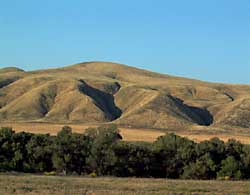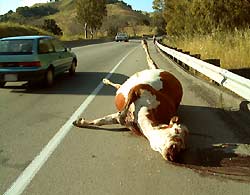|
DAY ONE: JUNE 1 |
ESPAÑOL |
LOS ANGELES–WATSONVILLE We begin the journey in a rented black Kia, on U.S. highway 101 north from Los Angeles: 360 miles and 7 seven hours to Watsonville, passing through the bread basket of California. Bumper to bumper traffic across the San Fernando Valley. Oak trees shading the hills above Ventura. The fertile coastal plain of Oxnard, where the strawberry fields will soon yield their fruit. And there they are, figures like ants on the horizon: the migrant workers bending into the earth. In an instant they are gone. The car swallows more landscape. The grazing hills, only a few short weeks ago bright green and ablaze with wildflowers, are fading to a tannish brown. 
Freshly tilled earth. Scent of garlic. Row upon row unto the horizon. Oil wells, pipelines. State penitentiary outside Soledad. The ghost-barracks of Camp Roberts, where a million men trained for the Wars. Billboards in English, in Spanish, announcing beer and motels and HIV and a town called Solvang. This is the second and final leg of this journey, an exploration of a much larger, and unfinished (or never-ending) journey. Joe and I went out on the road last year, following migrant families across the country. Today, we begin a month-long revisitation. To see how the road has changed, if at all. To see how the travellers have changed, if at all. This journey actually began in April of 1996. It began with Benjamin, Salvador and Jaime Chavez-Munoz boarding a third-class bus in their hometown of Cheran, Michoacan; mother and wives and kids and siblings wished them well on their trip to Watsonville for another season of strawberry picking. The bus travelled down from the highlands to Zamora, where they boarded another bus along with a crew of "pollos" (migrants) led by a "coyote" (smuggler). 30 hours to Tijuana, where they were herded into a house that reeked of piss and sweat and where they'd wait another several hours and then the knock on the door and everyone piled into a truck and off-- to cross the border that the American government tells the Mexican people not to cross, even though everyone who does so is rewarded with a job on the other side. The Chavez brothers crossed into the United States on foot in the wee hours, were herded into another truck, and within an hour and a half they were dead, along with five others crammed into the camper shell of the pickup. The driver of the truck, pursued by the Border Patrol, failed to negotiate a curve in the road. It happened in the hills above Temecula, a small town about 50 miles north of the border. On those hills, well-off Anglo retirees have built homes resembling, in a distorted, romantic way, the ranch homes of the Californios, the Mexican rancheros of early California. The Chavez brothers died within sight of those faux haciendas. So the journey begins with death, a death caused by a simple, mundane fact: the Chavez brothers did not count among their worldy possessions a particular piece of paper and plastic called a "green card," which establishes legal residence in the United States of America. Two other did have this document, and could move back and forth across the frontier at will. But not Benjamin, Salvador and Jaime. And the journey turns to the road that the brothers, and millions of others like them, were betting on. A road that has no beginning or end. The road to Watsonville. The road to America. Strawberry Fields Forever. Over the next few days, we will re-explore Watsonville, strawberry capital of the world, one of dozens of migrant Meccas in California. We will do so from the migrant perspective. Postscript: on the 101, just north of San Luis Obispo, an upper-class Anglo enclave about 100 miles north of Santa Barbara, we came across a road kill. 
It was a cow by the side of the road, hind legs frozen in the air, fresh enough for blood to stilll be bubbling up through its nose. Diamonds of glass were strewn across the asphal near the carcass, probably from a semi-truck's front end. We parked the car and walked back about a quarter mile along the highway, facing the 75 mile-an-hour traffic. Joe snapped several pictures. We were confronted by an off-duty sheriff's deputy, a woman of peroxide blonde hair. "Is that your animal?" No, we replied. "Well that's just sick," she said, disgusted by the fact that we were documenting the death of the animal. "That's just sick," she said again, with a face contorted with both a scowl and a look of perplexity, regarding us as if we were the ones who'd caused the accident. Perhaps she thought we were disrespecting the dead? No, we were just remembering them. Ruben Martinez Watsonville, June 2, 1998, 1:00 AM PDT |
|